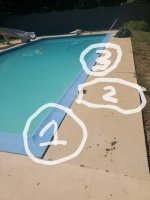Cover is pictured in photo, not sure the difference between solar or any other cover. Will explain the circles and numbers belowDo you have a solar cover? If not, you can be losing water to evaporation as well. this will also help your chlorine survive the sun with such low CYA.
you can also use dyes or food coloring near suspected underwater leaks, as they will have a vacuum effect. if indeed sucking water

1) furthest return location from pump house (located in line with the deck on other side of the blue fence). Return gets good pressure but the drop in the deck leaves me concerned of a possible Crack in the plumbing at this point since my remaining leaks are only during pump operation.
2)Crack running from skimmer to the grass, it's all the way through from grass until about 3/4ths way to skimmer. This could be caused by erosion under the deck due to leak in return, but this skimmer gets lower pressure than the one pictured further up at the deep end of the pool making me believe I might have an issue here as well.
3) location of wall port for vacuum. No cracks on this slab, but obvious recession. Vacuum pressure does not seem impeded at all, but this could also be the location of a leak in the pipes for the skimmer and/or the return noted in '1'.
There is no damage to any surface of the pool itself, only to the decking. I will be removing the deck slabs and exposing the plumbing to the return and the skimmer next week when I can get the tongs for the tractor installed to make sure I do not damage the pool during removal. These are the last of the major plumbing issues that I have to repair with the pool. In the pump house, I need to redo a LOT of the plumbing due to the previous owners "repair guy" using improper joint glue, improperly rated PVC, down sizing plumbing instead of buying the proper couplings (he used 2.5" to 2" converter couplings), need to add lock fasteners to be able to actually remove the filter valve without causing damage. Need to replace 2 shut off valves that are 'frozen' in the open position because the cement poured into the ball joint area when they were originally installed.







